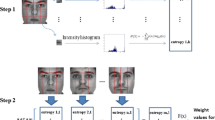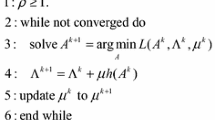Abstract
By representing a test sample with a linear combination of training samples, sparse representation-based classification (SRC) has shown promising performance in many applications such as computer vision and signal processing. However, there are several shortcomings in SRC such as 1) the l 2-norm employed by SRC to measure the reconstruction fidelity is noise sensitive and 2) the l 1-norm induced sparsity does not consider the correlation among the training samples. Furthermore, in real applications, face images with similar variations, such as illumination or expression, often have higher correlation than those from the same subject. Therefore, we correspondingly propose to improve the performance of SRC from two aspects by: 1) replacing the noise-sensitive l 2-norm with an M-estimator to enhance its robustness and 2) emphasizing the sparsity in terms of the number of classes instead of the number of training samples, which leads to the structured sparsity. The formulated robust structured sparse representation (RGSR) model can be efficiently optimized via alternating minimization method under the half-quadratic (HQ) optimization framework. Extensive experiments on representative face data sets show that RGSR can achieve competitive performance in face recognition and outperforms several state-of-the-art methods in dealing with various types of noise such as corruption, occlusion and disguise.















Similar content being viewed by others
References
Bickel PJ, Ritov Y, Tsybakov AB (2009) Simultaneous analysis of Lasso and Dantzig selector. Ann Stat 37(4):1705–1732
Bioucas-Dias JM, Figueiredo MA (2007) A new twist: two-step iterative shrinkage/thresholding algorithms for image restoration. IEEE Trans Image Process 16(12):2992–3004
Boyd S, Vandenberghe L (2004) Convex optimization. Cambridge University Press
Combettes PL, Wajs VR (2005) Signal recovery by proximal forward-backward splitting. Multiscale Model Simul 4(4):1168–1200
Ding C, Zhou D, He X, Zha H (2006) R1-PCA: rotational invariant L1-norm principal component for robust subspace factorization. Proc Int Conf Mach Learn 281–288
Donoho DL, Elad M (2003) Optimally sparse representation in general (nonorthogonal) dictionaries via l 1 minimization. Proc Natl Acad Sci 100(5):2197–2202
Du L, Li X, Shen Y-D (2012) Robust nonnegative matrix factorization via half-quadratic minimization. Proc IEEE Int Conf Data Min 201–210
Elhamifar E, Vidal R (2009) Sparse subspace clustering. Proc IEEE Conf Comput Vis Pattern Recognit 2790–2797
Geman D, Reynolds G (1992) Constrained restoration and the recovery of discontinuities. IEEE Trans Pattern Anal Mach Intell 14(3):367–383
Geman D, Yang C (1995) Nonlinear image recovery with half-quadratic regularization. IEEE Trans Image Process 4(7):932–946
Georghiades AS, Belhumeur PN, Kriegman D (2001) From few to many: illumination cone models for face recognition under variable lighting and pose. IEEE Trans Pattern Anal Mach Intell 23(6):643–660
Grave E, Obozinski GR, Bach FR (2011) Trace Lasso: a trace norm regularization for correlated designs. Proc Adv Neural Inf Proces Syst 2187–2195
Gross R, Matthews I, Cohn J, Kanade T, Baker S (2010) Multi-PIE. Image Vis Comput 28:807–813
He R, Sun Z, Tan T, Zheng W-S (2011) Recovery of corrupted low-rank matrices via half-quadratic based nonconvex minimization. Proc IEEE Conf Comput Vis Pattern Recognit 2889–2896
He R, Zheng W-S, Hu B-G (2011) Maximum correntropy criterion for robust face recognition. IEEE Trans Pattern Anal Mach Intell 33(8):1561–1576
He R, Zheng W-S, Tan T, Sun Z (2014) Half-quadratic-based iterative minimization for robust sparse representation. IEEE Trans Pattern Anal Mach Intell 36(2):261–275
Huber PJ (2011) Robust statistics. Springer
Lai J, Jiang X (2014) Supervised trace lasso for robust face recognition. Proc IEEE Int Conf. Multimedia Expo 1–6
Lee HY, Hoo WL, Chan CS (2015) Color video denoising using epitome and sparse coding. Expert Syst Appl 42(2):751–759
Lee K-C, Ho J, Kriegman D (2005) Acquiring linear subspaces for face recognition under variable lighting. IEEE Trans Pattern Anal Mach Intell 27(5):684–698
Liu W, Pokharel PP, Principe JC (2007) Correntropy: properties and applications in non-gaussian signal processing. IEEE Trans Signal Process 55(11):5286–5298
Lu C, Tang J, Lin M, Lin L, Yan S, Lin Z (2013) Correntropy induced l2 graph for robust subspace clustering. Proc IEEE Int Conf Comput Vis 1801–1808
Martinez AM (1998) The AR face database, CVC Technical Report
Nie F, Huang H, Cai X, Ding CH (2010) Efficient and robust feature selection via joint l2, 1-norms minimization. Proc Adv Neural Inf Proces Syst 1813–1821
Nikolova M, Ng MK (2005) Analysis of half-quadratic minimization methods for signal and image recovery. SIAM J Sci Comput 27(3):937–966
Rosas-Romero R, Tagare HD (2014) Segmentation of endocardium in ultrasound images based on sparse representation over learned redundant dictionaries. Eng Appl Artif Intell 29:201–210
Tibshirani R (1996) Regression shrinkage and selection via the Lasso. J R Statist Soc B 58(1):267–288
Turk M, Pentland A (1991) Eigenfaces for recognition. J Cogn Neurosci 3(1):71–86
Wagner A, Wright J, Ganesh A, Zhou Z, Ma Y (2009) Towards a practical face recognition system: robust registration and illumination by sparse representation. Proc IEEE Conf Comput Vis Pattern Recognit 597–604
Wright J, Yang AY, Ganesh A, Sastry SS, Ma Y (2009) Robust face recognition via sparse representation. IEEE Trans Pattern Anal Mach Intell 31(2):210–227
Yang AY, Zhou Z, Balasubramanian, Sastry SS, Ma Y (2013) Fast l1-minimization algorithms for robust face recognition. IEEE Trans Image Process 22(8):3234–3246
Yang M, Zhang L (2010) Gabor feature based sparse representation for face recognition with Gabor occlusion dictionary. Proc Eur Conf Comput Vis 448–461
Yang M, Zhang L, Yang J, Zhang D (2010) Metaface learning for sparse representation based face recognition. Proc Int Conf Image Proces 1601–1604
Yang M, Zhang L, Yang J, Zhang D (2011) Robust sparse coding for face recognition. Proc IEEE Conf Comput Vis Pattern Recognit 625–632
Yang S, Lv Y, Ren Y, Jiao L (2013) Superpixel-wise semi-supervised structural sparse coding classifier for image segmentation. Eng Appl Artif Intell 26(10):2608–2612
Zhang L, Yang M, Feng X (2011) Sparse representation or collaborative representation: Which helps face recognition?. Proc IEEE Int Conf Comput Vis 471–478
Zhao P, Yu B (2006) On model selection consistency of Lasso. J Mach Learn Res 7:2541–2563
Acknowledgments
The authors would like to thank the anonymous reviewers for their helpful comments on this paper. This work was partially supported by the National Natural Science Foundation of China (No.61272248), the National Basic Research Program of China (No.2013CB329401), the Science and Technology Commission of Shanghai Municipality (No.13511500200) and the funding of Hangzhou Dianzi University (KYS055616025).
Author information
Authors and Affiliations
Corresponding author
Rights and permissions
About this article
Cite this article
Peng, Y., Lu, BL. Robust structured sparse representation via half-quadratic optimization for face recognition. Multimed Tools Appl 76, 8859–8880 (2017). https://doi.org/10.1007/s11042-016-3510-3
Received:
Revised:
Accepted:
Published:
Issue Date:
DOI: https://doi.org/10.1007/s11042-016-3510-3




